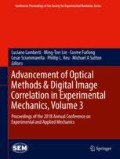Abstract
Digital image correlation (DIC) is a powerful experimental technique to compute full-field displacements and strains. The basic idea of the method is to compare images of an object decorated with a speckle pattern before and after deformation, and thereby to compute displacements and strains. Since DIC is a non-contact method that gives the whole field deformation, it is widely used to measure complex deformation patterns. Finite element (FE)-based Global DIC with regularization is one of the commonly used algorithms and it can be combined with finite element numerical simulations at the same time (Besnard et al., J Strain Anal Eng Design 47(4):214–228, 2012). However, Global DIC algorithm is usually computationally expensive and converges slowly. Further, it is difficult to directly apply an adaptive finite element mesh to Global DIC because the stiffness matrix and the external force vector have to be rebuilt every time the mesh is changed.
In this paper, we report a new Global DIC algorithm that uses adaptive mesh. It builds on our recent work on the augmented Lagrangian digital image correlation (ALDIC) (Yang and Bhattacharya, Exp Mech, submitted). We consider the global compatibility condition as a constraint and formulate it using an augmented Lagrangian (AL) method. We solve the resulting problem using the alternating direction method of multipliers (ADMM) (Boyd et al., Mach Learn 3(1):1–122, 2010) where we separate the problem into two subproblems. The first subproblem is computed fast, locally and in parallel, and the second subproblem is computed globally without image grayscale value terms where nine point Gaussian quadrature works very well. Compared with current Global DIC algorithm, this new adaptive Global DIC algorithm decreases computation time significantly with no loss (and some gain) in accuracy.
Access this chapter
Tax calculation will be finalised at checkout
Purchases are for personal use only
References
Sutton, M.A., et al.: Image Correlation for Shape, Motion and Deformation Measurements: Basic Concepts, Theory and Applications (2009)
Pan, B., Qian, K., Xie, H., et al.: Two-dimensional digital image correlation for in-plane displacement and strain measurement: a review. Meas. Sci. Technol. 20(6), 062001 (2009)
Besnard, G., Leclerc, H., Hild, F., et al.: Analysis of image series through global digital image correlation. J. Strain Anal. Eng. Design. 47(4), 214–228 (2012)
Nochetto, R.H., Siebert, K.G., Veeser, A.: Theory of adaptive finite element methods: an introduction. In: Multiscale, nonlinear and adaptive approximation, pp. 409–542. Springer, Berlin (2009)
Yuan, Y., Huang, J., Fang, J., et al.: A self-adaptive sampling digital image correlation algorithm for accurate displacement measurement. Opt. Lasers Eng. 65, 57–63 (2015)
Hild, F., Roux, S.: Digital image correlation. Wiley-VCH, Weinheim (2012)
Wittevrongel, L., et al.: A self adaptive global digital image correlation algorithm. Exp. Mech. 55(2), 361–378 (2015)
Baker, S., et al.: Lucas-Kanade 20 years on: a unifying framework. Int. J. Comput. Vis. 56(3), 221–255 (2004)
Henn, S.: A Levenberg–Marquardt scheme for nonlinear image registration. BIT Numer. Math. 43(4), 743–759 (2003)
Boyd, S., Parikh, N., Chu, E., et al.: Distributed optimization and statistical learning via the alternating direction method of multipliers. Mach. Learn. 3(1), 1–122 (2010)
Haber, E., Heldmann, S., Modersitzki, J.: Adaptive mesh refinement for nonparametric image registration. SIAM J. Sci. Comput. 30(6), 3012–3027 (2008)
Yang, J., Bhattacharya, K.: Augmented Lagrangian DIC. Submitted to Experimental Mechanics
Yang, J., Bhattacharya, K.: Fast Adaptive Global Digital Image Correlation. In preparation
Acknowledgement
We gratefully acknowledge the support of the US Air Force Office of Scientific Research through the MURI grant ‘Managing the Mosaic of Microstructure’ (FA9550-12-1-0458).
Author information
Authors and Affiliations
Editor information
Editors and Affiliations
Rights and permissions
Copyright information
© 2019 The Society for Experimental Mechanics, Inc.
About this paper
Cite this paper
Yang, J., Bhattacharya, K. (2019). Fast Adaptive Global Digital Image Correlation. In: Lamberti, L., Lin, MT., Furlong, C., Sciammarella, C., Reu, P., Sutton, M. (eds) Advancement of Optical Methods & Digital Image Correlation in Experimental Mechanics, Volume 3. Conference Proceedings of the Society for Experimental Mechanics Series. Springer, Cham. https://doi.org/10.1007/978-3-319-97481-1_7
Download citation
DOI: https://doi.org/10.1007/978-3-319-97481-1_7
Published:
Publisher Name: Springer, Cham
Print ISBN: 978-3-319-97480-4
Online ISBN: 978-3-319-97481-1
eBook Packages: EngineeringEngineering (R0)

